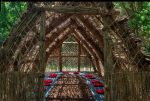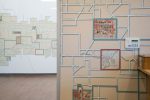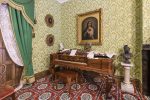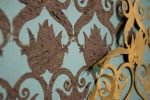This week’s Weekly has my review of Swarm at the Schuylkill Center for Environmental Education. Below’s the copy with some pictures. More photos at flickr.
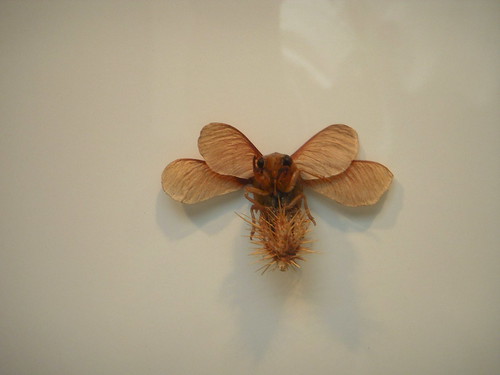
Lisa Murch. detail, Spring, Forbidden Drive 2008. insect specimens made from cicada exoskeletons to which “wings” and “antennae” and other features are added — all made from seed pods and forest floor matter. At Schuylkill Center for Environmental Education.
The 2006 group show “Swarm” at the Fabric Workshop and Museum explored the idea of highly metaphorical non-insect swarm behavior, like flash mobs and data clusters. This year’s “Swarm” at the Schuylkill Center for Environmental Education (SCEE) brings the focus back to our insect friends.

Lisa Murch. detail, Spring, Forbidden Drive, 2008.
The works by the seven artists range in approach, and lest you be afraid, you won’t see any flying cockroaches or screaming mosquito images in this show. What you will see, however, in works ranging from lyrical to spooky to whimsical, is an insect celebration that sometimes feels right out of the Victorian era’s love of collecting, cataloging and displaying the wonders of the natural world.
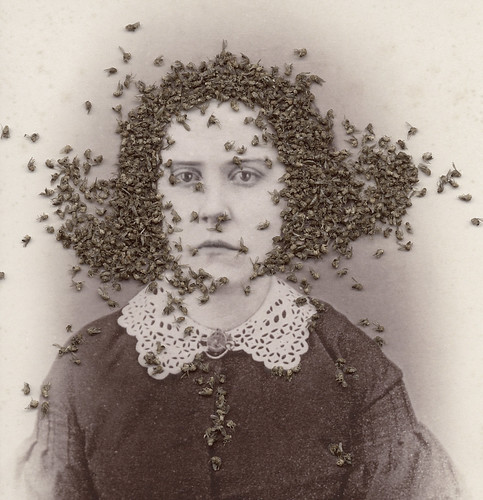
Greene’s “Coiffed: A Typology of Entropic Variations” is a series of found Victorian-era photo portraits onto which the artist collaged a swarm of laboratory flies in fanciful hairlike arrangements around the face. She photographs the buggy pompadours and walrus mustaches on the staid-looking Victorians, and what you see is so trompe l’oeil that you may believe these Victorians were sideshow performers in a circus and the bugs were on them in real time. Every time I see Greene’s works I squirm because the reality they suggest is so palpable it provokes a gut reaction. Greene works with actual dead Drosophila, the fruit flies used in lab experiments. She says she’s always been very interested in nature so her images aren’t gimmicks but curiosities from a mind that’s playful and enjoys taking liberties.

Talia Greene, Coiffed. Click to see the fabulous coiffures and facial whiskers made by the little flies.
Lisa Murch’s “Species” is also typological and Victorianesque. Three display cases on the wall contain a grid of insects pinned or glued to paper in a display that looks right out of the Academy of Natural Sciences museum. But close observation of the different bugs reveal that they’re not bugs at all but fabricated critters from the discarded exoskeletons of cicadas to which the artist affixes wings, antennae, stingers and so on to make a new species. All the parts are from natural materials found in the woods. Murch, too, is a nature lover, and this piece, with its nod to scientific research and to bug collecting done by kids of all ages, is a delight.

Matt Stemler’s Elephant Lift, (detail) watercolor 11×30″
B.A. Bosaiya’s black-and-white cinematic close-up photos of dead bees found in his garden and dead moths attracted by the light outside his back door add a note of drama to the show. If you want to anthropomorphize bugs, Bosaiya’s work will get you there. His Epson inkjet prints give these tiny domestic menaces the scary affect of the highly articulated beasts in the movie Alien.
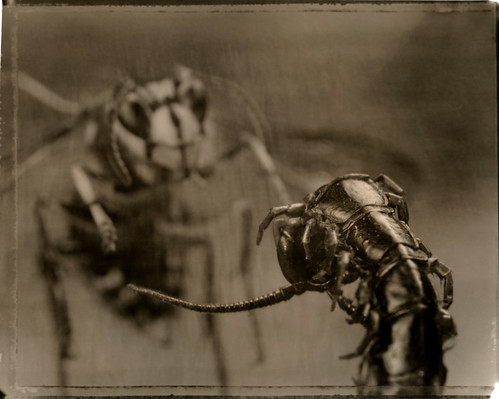
B. A. Bosaiya’s archival Epson inkjet prints
Kt Carney’s dragonfly sculptures made of steel adorn the walls like friendly jewels. The largest dragonfly, at 58 inches long with a 58-inch wingspan, has a friendly, loopy quality and is adorable.

Kt Carney’s dragonflies on the wall.
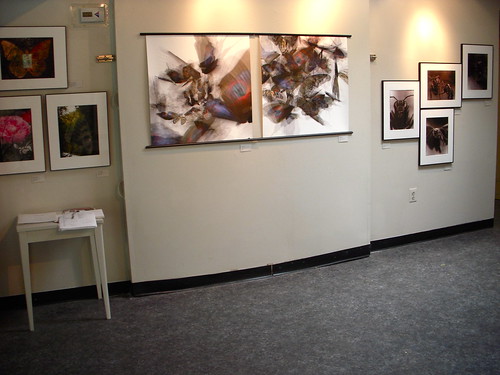
Installation shot with (l-r) Rosalind Sutkowski, Richard Ryan and B.A. Bosaiya’s works.
Matt Stemlar’s charcoal drawings and watercolor paintings have a sweet, children’s-book-illustration quality. And Rosalind Sutkowski and Richard Ryan are just crazy for butterflies.
At a time when the words “colony collapse” don’t refer to humans behaving badly but to honeybees decimated by a mystery virus, it’s right for there to be a show of insect love. This is a very sweet show with its heart in the right place. Look for an expansion of SCEE’s outdoor art programming this fall courtesy of a grant from the William Penn Foundation.
“Swarm”
Through Aug 29.
Schuylkill Center for Environmental Education,
8480 Hagy’s Mill Rd.
215.482.7300.


